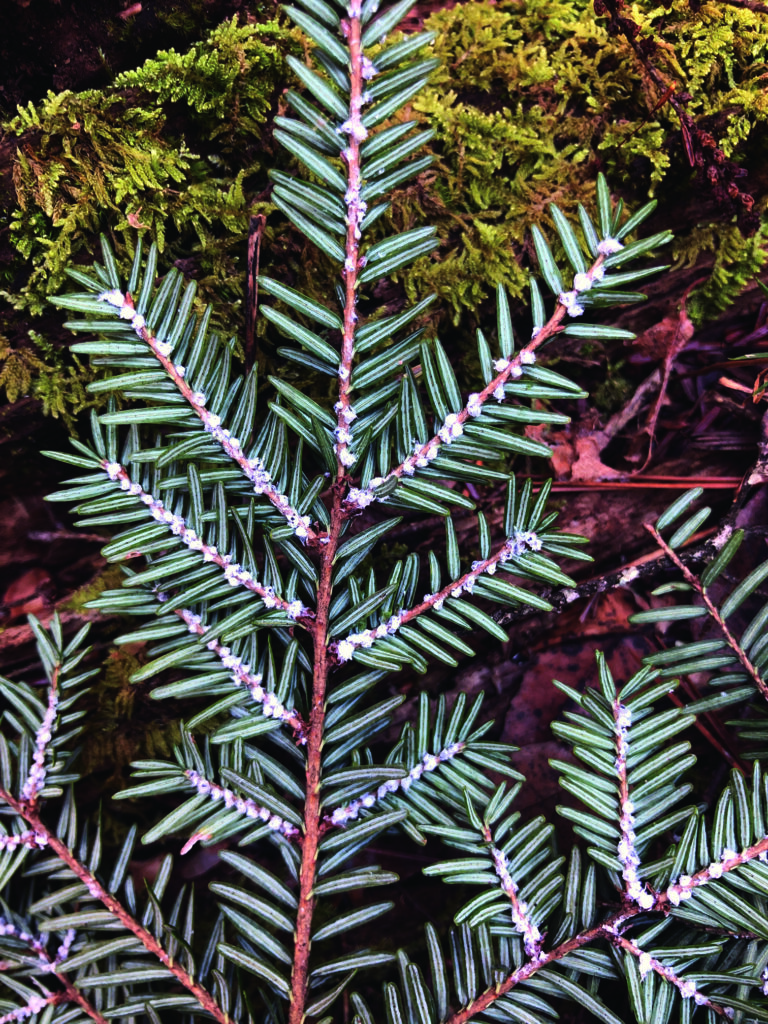
Invasive insects make a meal out of county’s hemlocks
By Kevin Limiti
An invasive species with an odd name is causing concern in Otsego County after conservationists discovered the destructive insect at parks in Cooperstown and around Oneonta.
The Hemlock Wooly Adelgid (HWA) is a tiny bug that infests hemlock trees, which experts warn could cause catastrophic environmental damage.
The insect in question came from the Far East in the 1920s and was discovered in New York State in the 1980s, and gets it name from the wool-like mask it generates around itself and looks like a cotton ball in the trees when an infestation is bad enough.
Now, it has been found ravaging hemlock in Fairy Springs Park in Cooperstown and Robert V. Riddell Park in Davenport.
Otsego County Conservation Association (OCCA) Program Director Jeff O’Handley said his group plans to organize volunteers to survey the area to find out the extent to which the critters have made their way into town.
“If we get a widespread infestation we could lose a lot of the hemlock trees,” Mr. O’Handley said. “We could see changes in water, trout fishing, and economic destruction through soil erosion.”
The trees are important to the landscape, providing food and shelter for wildlife and maintaining water quality with shade. Common throughout the Adirondacks and the Catskills, they tend to grow on top of steep slopes; here they surround the shores of Otsego Lake and other spaces across the county.
The unwelcome insects feed on the base of the hemlock’s needles, resulting in the deaths of limbs, and ultimately cause the entire tree to die within a decade. And because they have no natural predators in Otsego County and reproduce quickly, HWAs could cause a lot of damage if left unchecked.
The Clark Foundation, OCCA, the Cornell Hemlock Initiative (CHI), and other organizations have worked together on combating HWA since 2017. Devin Merkley, who represents the Clark Foundation, said they have been aware of the HWA problem.
“This has been on our radar for some time,” Mr. Merkley said, telling The Freeman’s Journal/Hometown Oneonta he discovered the infestation near Fairy Springs Park. “Citizen science and volunteer scouting are crucial to detecting HWA infestations early, and early detection is crucial to management. We are working now to build awareness around this invasive species so that local landowners can monitor and scout for HWA on their own properties or perhaps anywhere they happen to be among hemlock trees.”
Steve Kinne, a volunteer for CHI, heads a Central New York HWA Hunters team and verified the infestation. Along with a group of volunteers, he surveys land to search for any sign of the invasive species.
CHI targeted Fairy Springs after seeing HWA patterns in the Finger Lakes region. They first found no evidence in survey areas but discovered a suspected infestation in December 2021.
“Having just looked at that area eight months before, that was a big deal,” Mr. Kinne said. “We went back to confirm his finding and sure enough, it was HWA. We fanned out even further, finding scattered infected trees until we examined trees right near the building at Fairy Springs and found obvious, well-established infections of most of the hemlocks. This was humbling to our team.”
Oneonta Mayor Mark Drnek mentioned HWA at the city’s Common Council meeting on January 18, with the Environmental Board issuing a warning via its Facebook page by sharing a post from OCCA.
Fighting a similar battle against HWAs at the North-South Lake Campground in Greene County last year, the state’s Department of Environmental Conservation released predator beetles that feed only on HWAs throughout fall and winter. One expert, though, said that strategy should not be the focus in Otsego County.
“Biocontrol is a long-term management strategy, a way to keep hemlocks on the landscape as a functional part of our forests,” said Caroline Marschner of the New York State Hemlock Initiative. “The response Cooperstown needs to focus on right now is short-term management, keeping today’s hemlocks alive and supporting the ecosystem they are part of right now. Both are critical components to an effective conservation strategy in the face of HWA.”
HWAs are not the only invasive species threatening the environment in Otsego County. The Asian Long-horn Beetle causes devastation to urban New York, but could threaten upstate forests if it spreads. The Emerald Ash Borer damages ash trees, a common form of commercial timber.
OCCA recommends that those who find trees with a clear indication of infection take a photograph, make detailed notes about the location including GPS points if possible, and submit findings to the iMapInvasives mobile app or email the DEC Forest Health unit at foresthealth@dec.ny.gov.
OCCA, along with Mohican Farms/The Clark Foundation, are hosting two workshops on HWA including an informational session on January 27 at 7 p.m. that gives an overview of the problem. Anyone interested in volunteering to help root out the uninvited bug can register for field training on January 29.
For more information, go to https://occainfo.org/occa-calendar/

